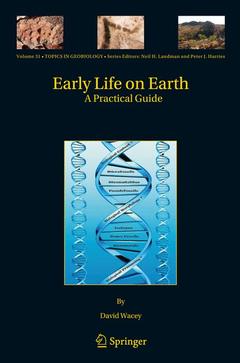Description
Early Life on Earth, 2009
A Practical Guide
Topics in Geobiology Series, Vol. 31
Author: Wacey David
Language: English
Subjects for Early Life on Earth:
Keywords
Archean; Biosignatures; Early Life; Microfossils; carbon; earth; tree
Approximative price 105.49 €
In Print (Delivery period: 15 days).
Add to cartPublication date: 11-2014
274 p. · 15.5x23.5 cm · Paperback
Approximative price 105.49 €
Subject to availability at the publisher.
Add to cartPublication date: 01-2009
274 p. · 15.5x23.5 cm · Hardback
Description
/li>Contents
/li>Biography
/li>Comment
/li>
When did life first appear on Earth and what form did it take? The answer to this intriguing and fundamentally important question lies somewhere within the early Archean rock record. The young Earth was, however, a very different place to that we know today and numerous pitfalls await our interpretation of these most ancient rocks.
The first half of this practical guide equips the reader with the background knowledge to successfully evaluate new potentially biological finds from the Archean rock record. Successive steps are covered, from locating promising samples in the field, through standard petrography and evaluation of antiquity and biogenicity criteria, to the latest state of the art geochemical techniques. The second half of the guide uniquely brings together all the materials that have been claimed to comprise the earliest fossil record into an easily accessible, fully illustrated format.
This will be a handbook that every Archean geologist, palaeobiologist and astrobiologist will wish to have in their backpack or on their lab-bench.
David Wacey is a University Research Fellow at the University of Western Australia in Perth. He graduated with honours from Oxford University in 1998 and then undertook a D.Phil. investigating the geochemistry and microbiology of modern and ancient dolomite formation. It was during this time that he became interested in primitive microbes and how the earliest life on Earth may have arisen and evolved. On completion of his D. Phil he decided to concentrate his research on the earliest rocks found on Earth. After 12 years at Oxford he relocated to Western Australia where he now works on a number of problems relating to the recognition and understanding of the earliest signs of life of Earth. More information can be found here: http://cmca.uwa.edu.au/contact_directory
The main aim is to draw attention to the remarkable number of highly interesting candidate structures in the quest to decode the earliest evidence for life on Earth
Will cover the Victorian Eozoon controversy, the ongoing stromatolite debate, and the recent Apex microfossil debate
Features a large number of geochemical high resolution illustrations including thin section photomicrographs, field outcrop photographs and scanning electron microscope images including detailed descriptions and balanced interpretations of the structures so that the reader can compare and contrast
Will act as a reference guide and practical pictorial textbook for students and researchers into early life




